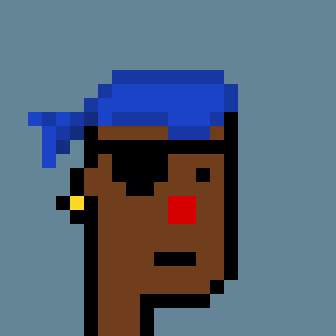
CryptoPunk #6649
Custom software, still image, NFT, and Ethereum blockchain, 2017
Private collection
CryptoPunks is a series of 10,000 unique digital characters, each generated by an algorithm. Matt Hall and John Watkinson of Larva Labs wrote a computer program that combined various traits—hairstyles, accessories, facial expressions—to create each Punk. The algorithm determined the combinations, but Hall and Watkinson defined the parameters, deciding which traits to include and how rare certain features would be (like the handful of blue-skinned “alien” Punks).
CryptoPunks was among the first works linked to blockchain technology and one of the first prototypes of non-fungible tokens (NFTs). Each has a unique identifier stored on Ethereum, one of the largest public blockchain platforms. This ensures its authenticity, ownership, and ownership history can be verified and traced. A decentralized digital marketplace is built into the work itself, allowing anyone in the world to buy, sell, and track the punks’ value. CryptoPunks has become a cultural phenomenon, influencing how we think about digital ownership, online identity, and the value of digital art.
A step-by-step set of instructions or rules for solving a problem or completing a task. A recipe is an algorithm, as is a computer program.
A digital ledger that stores information across many computers instead of one central location. Each new record links to previous ones, forming a secure chain of “blocks” (packages of encrypted data) that is extremely difficult to alter or hack. Blockchain technology has been used to create cryptocurrencies and non-fungible tokens (NFTs) due to its ability to securely record transactions without requiring the authentication of a centralized regulatory body.
A unique digital certificate stored on a blockchain that proves ownership of a specific digital asset like artwork, music, or videos. An NFT works like a contract of ownership, recording data like sales and trading information. Unlike cryptocurrencies, each NFT is non-fungible, meaning it’s one-of-a-kind and cannot be exchanged equally with another, making it ideal for digital collectibles.
Spread out rather than concentrated in one place. In decentralized systems, control, power, and decision-making are distributed among many participants or nodes rather than managed by a single, central authority.










